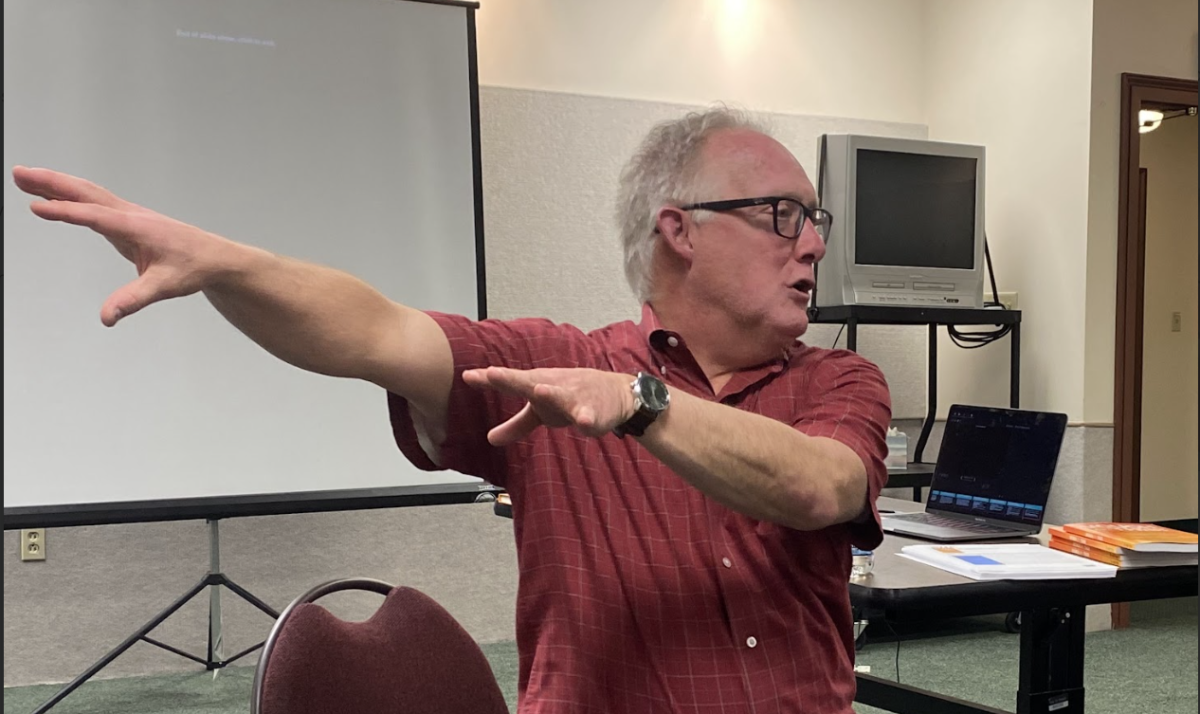EdChoice, a state program that assists families in paying for private school, undermines community integration and ultimately harms children, Thomas Poetter, professor of educational leadership at Miami University, told an audience organized by the League of Women Voters Oxford.
“Everything that anybody has ever said about private charter schools and voucher schools helping disadvantaged students, raising test scores, integrating society … is wrong,” Poetter told a crowd of about 25 people in a packed LCNB National Bank community room on March 13.
EdChoice, according to Ohio’s Department of Education and Workforce, provides students from select public schools the opportunity to attend private school within the parameters of a certain household income level and for public schools deemed “failing” by the state.
Last August, the EdChoice Expansion program – which expands both the eligible household income level and removes the “failing” designation requirement for public schools – was allotted a $2 billion outlay over the next two years within the state’s budget, Poetter said.
Families may be awarded, at maximum for the lowest federal poverty level, $6,165 for students grades K-8 and $8,407 for high school students.
Public money is used to fund private entities via these EdChoice programs. According to News 5 investigators out of Cleveland, Ohio, following the legislation change in August, EdChoice Expansion vouchers were already directing “more than $100 million taxpayer dollars to private schools.”
Poetter said EdChoice is a “money-grab” and that it is “deteriorating the public sphere.”
Poetter said private schools are not available in the areas where many students of color and low-income students live. Many parents also cannot afford outside costs like transportation and books. For wealthier families, EdChoice Expansion is a “huge bounce in their own bank accounts.”
Supporters of EdChoice, like those at The Buckeye Institute, a Columbus think-tank centered on free-market policy, see the situation differently.
“EdChoice has long been a program that helped underserved students that needed something different from what they were getting in their traditional district schools,” Greg Lawson, a research fellow at The Buckeye Institute, said in an email. “The EdChoice expansion now allows all families to take advantage of education opportunities and find the right fit for every student in every family in every community.”
According to Public Education Partners and data collected in June 2023 by Susie Kaeser, the education specialist for the League of Women Voters of Ohio, 11 out of Ohio’s 88 counties have no private school.
“What becomes of our democratic republic when we create seemingly parallel systems of education that overwhelmingly advance the segregation of students of color and those who are in low income residents?” Poetter said.
When the program expanded further in August, according to data from the Ohio Coalition for Equity and Adequacy of School Funding (E&A), 90% of the new beneficiaries were white.
The League of Women Voters is a nonpartisan organization with a policy position that supports quality public education.
“The organization doesn’t say ‘we don’t like private schools,’ but in this case we are seeing this massive amount of funding going to private schools,” Ellen Price, social policy portfolio director for League of Women Voters Oxford, said.
Price said the lack of bussing for Talawanda High School students crystalized this issue for her. Even though Talawanda has stopped bussing its own high school students, Poetter said, it cannot stop bussing students in its district to Badin High School due to decades-old legislation.
“It was just so heartbreaking to me that rural students in our area didn’t have a bus to get to school,” Price said. “What if their parents didn’t have a good car, what if there was no one available to drive them?”
Ted Caudill, a social studies teacher at Talawanda High School and vice president of the union representing teachers, said that a public school gets less money per student than a private school would get from a voucher.
“Talawanda gets about $3,000 per student,” Caudill said. “If the same exact kid goes to Moler or St. X or La Salle [they] will get $8,500 from the state, but Talawanda doesn’t.”
“Vouchers Hurt Ohio” case
The constitutionality of the EdChoice program is being questioned by the Ohio E&A in court case, “Vouchers Hurt Ohio,” that is scheduled to be heard in 2025.
According to the Vouchers Hurt Ohio website, a coalition of public school districts are suing the state and citing a number of issues within the lawsuit. Those include “the unconstitutionality of the school voucher program, unlawful diversion of tax revenues, religious issues, the Thorough and Efficient Clause in the Ohio Constitution, [and] equal protection.”
According to Poetter, 150 public school districts in Ohio have signed onto the case out of the just over 600 total in the state.
Ohio E&A lists the signed school districts on its website, including Hamilton City School District. Talawanda School District is not currently on the list.
Poetter said during the Q&A portion of the event that he cannot speak for Talawanda School District, but in his close relations with other districts he’s come to understand there are political reasons not to sign on.
“Every district that signs on hurts the state’s case,” Poetter said.








